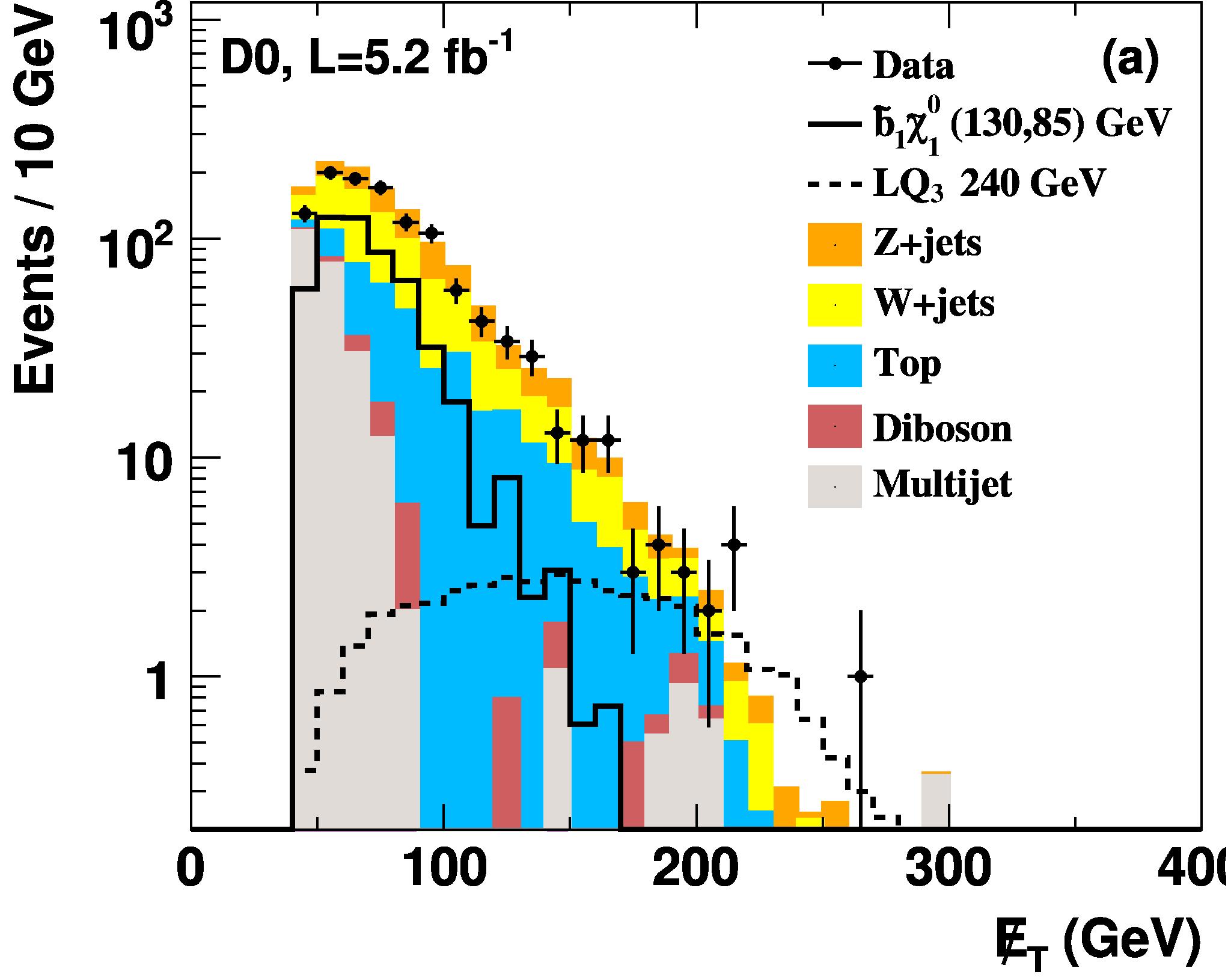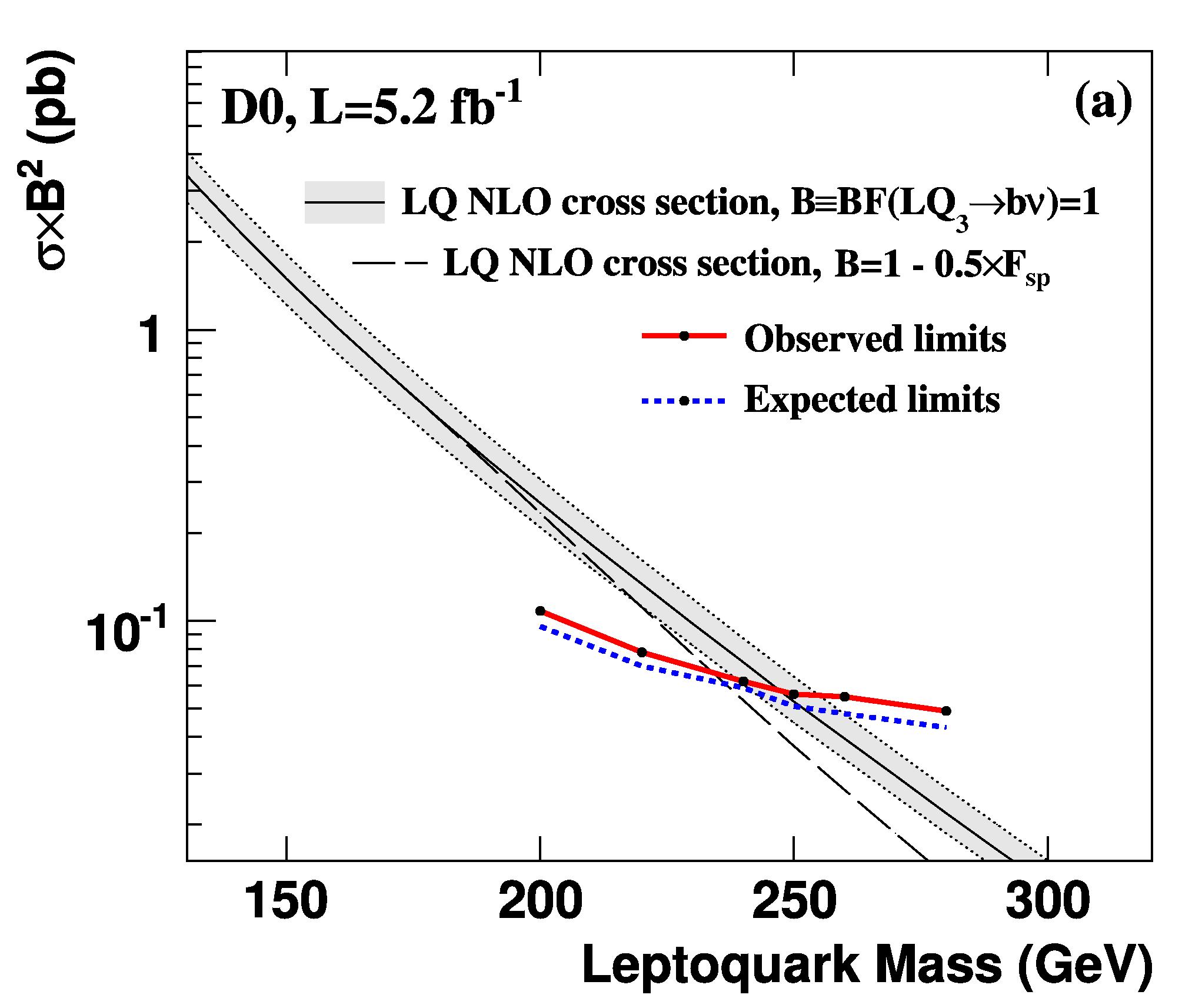
Two possible new phenomena share the same decay signature of 2 bottom quarks and missing energy. This page discusses third generation leptoquarks while scalar bottom quarks are discussed in the other page.
Experiments at Fermilab have searched for a third generation leptoquark, a never before seen exotic particle that, if it were ever found, might help explain why there are three generations of quarks and leptons. This search has included two NIU students, Andriy Zatserklyaniy and Sergey Uzunyan, who received their Ph.D.s in 2006 doing this analysis as part of the D0 collaboration. The data still doesn't show any evidence for these particles but a 2007 PRL paper raised the masses excluded to over 229 for charge 1/3 leptoquarks. In addition, a similar search for charge 2/3 and 4/3 third generation leptoquarks (done mostly by colleagues from Stony Brook) has also been published by the D0 collaboration in PRL. Recently, a PLB paper was published in 2010 using new data which raises this limit to 247 GeV.
The world we live in is made from a handful of elementary particles. The current understanding has twelve particles and their corresponding antiparticles out of which normal matter, like atoms, is composed. The twelve particles can be separated into two groups of six based on how they are affected by the strong nuclear force. Some particles, called leptons, are unaffected by the strong force under any circumstances. The most familiar lepton is the electron. Other members of this group include neutrinos and the muon and tau particles. The second group consists of quarks. Quarks do feel the strong nuclear force and it dominates their existence so much that we can not directly observe single quarks, but only combinations of quarks bound together by the strong force. Protons and neutrons are examples of particles made from bound quarks. This Table shows the relationship between the particles:

The six quarks and six leptons are each grouped in three pairs by the weak nuclear force which causes transitions between the two members of a pair. Some forms of radioactive decay are due to this. The three pairs of quarks and three pairs of leptons are ordered by mass. For leptons, the electron and its neutrino constitute the lowest mass pair, which we designate as the first generation of leptons. Similarly, the muon and its neutrino are the second generation, and the tau and its neutrino the third generation. The three quark generations are the up and down quark (from which protons and neutrons are made), the strange and charm quarks, and the top and bottom quarks. As the second and third generation particles are heavier, the weak nuclear force causes these particles to decay to the lightest leptons and quarks. Thus normal atoms are made from only first generation particles with the heavier generations existing only briefly either as the results of high energy interactions, or in the very hot early universe.
At the present time, we do not have any understanding why nature has three (and seemingly only three) generations of leptons and quarks. We also do not understand why they both come in three generations and it is tempting to ascribe the equality of the number of lepton and quark generations to a new, as yet unknown, higher symmetry. One such higher grouping predicted in many theories is the existence of new massive particles called leptoquarks which, in some sense, are more fundamental. Leptoquarks have the properties of both types of particles and would decay into a lepton and a quark. Three different types of leptoquarks would need to exist, and we label them first, second and third generation leptoquarks. Each generation of leptoquarks is constrained by experimental evidence to decay to only leptons and quarks of its own generation. So first generation leptoquarks decay to up or down quarks and an electron or electron-neutrino.
The DØ and CDF collaborations at Fermilab have searched for leptoquarks of all three generations. Third generation leptoquarks will decay to top or bottom quarks plus a tau or tau-neutrino. One possible decay mode is to a tau neutrino plus a b quark. This can occur if the electric charge of the leptoquark is 1/3. This is the channel used in the DØ search described here (the charge 2/3 and 4/3 search mentioned in the introduction uses the b+tau mode). The most likely way to produce leptoquarks at the Fermilab collider is in leptoquark-antileptoquark pairs. If each decays in the same way, the final state would have two neutrinos and two bottom quarks.
Bottom quarks decay to charm quarks which then decay to strange quarks. These decays are caused by the weak nuclear force. The lifetime of a b quark is very short, about one trillionth of a second, but the particle can still travel a few mm before it decays. Also, about 10% of the time, each weak decay produces a muon. We can identify a bottom quark either by the presence of particles which are separated from the point where the proton-antiproton collision occurred or if there is a a muon. In both cases there is also a spray of strongly interacting debris made from quarks. This spray of particles is called a ``jet''.
Three components of the DØ detector allow us to identify bottom quark decay. The first is the calorimeter which is made from plates of uranium immersed in liquid argon. Particles made from quarks (like protons and pions) plus photons and electrons will undergo many interactions with the uranium creating a ``shower'' of additional particles. These particles can be detected through their ionization in the liquid argon and allows us to measure the energy of the jet. Muons travel through material slowly losing energy through ionization. To detect muons, we place a thick iron magnet after the calorimeter, and identify any particle which passes through both the calorimeter and the magnet as a muon. Finally, we surround the place where the proton-antiproton collision occurs with dtectors made from silicon. This is, in effect, a digital camera. It allows us to measure particle directions very accurately and select those jets with a secondary decay point, which are mostly due to b-quarks.
Neutrinos are very weakly interacting particles and travel through our detector without leaving any traces of information. To infer that a proton-antiproton collision produced one or more energetic neutrinos, we look for an imbalance in the detected energy. We define a quantity called missing energy by vectorially summing all the energy in the calorimeter and in detected muons. The horizontal and vertical components of these energy sums are combined to determine the missing energy. If the value for missing energy is large, this is most likely due to the presence of neutrinos. Leptoquarks would produce energetic neutrinos and thus have missing energy larger than our 90 GeV requirement.
After requiring 2 b-jets and some missing energy, we look at quantities like missing energy and the total energy of the event. We can attempt to understand the source of the collisions which have a neutrino plus bottom quarks final state. Top-antitop quark decays produce multiple bottom quarks and missing energy, but with additional, energetic jets. W boson decays to a muon and a neutrino can occasionally mimic a bottom quark decay. Thus the estimated amount from known processes is in good agreement with what we see in the data. As we do not observe an excess, there can not be very many collisions which produce leptoquark pairs. We can use this to set a limit on the probability to produce a leptoquark pair in any given proton-antiproton collision.

Most proton-antiproton collisions do not produce massive particles such as leptoquarks. The number of leptoquarks we might observe in our detector depends on a production probability multiplied by the number of proton-antiproton collisions and then multiplied by our detection efficiency. The detection efficiency for leptoquark pairs is calculated using a simulation program. Knowing these three terms allows us to calculate the upper limit on the third generation leptoquark production probability; that is we know the probability must be less than this value. These upper limits are shown in the figure as a function of leptoquark mass. The scale on this figure is in ``cross section in picobarns (pb)'' which is directly related to probability. As an example, a 0.1 pb process occurs about 2 times in 1 billion proton-antiproton collisions.
If leptoquarks exist, we can use theory to calculate the probability of producing them in proton-antiproton collisions. Since the strong nuclear force affects leptoquarks the same way as quarks, the production of leptoquark pairs is similar to producing heavy quark pairs, with heavier objects being harder to produce. The figure shows the theoretical cross section for the production of leptoquark pairs. The intersection of our limit curve with the theory band is at 247 GeV/c2. This is our lower limit on the mass of a charge 1/3 third generation leptoquark. If the leptoquark mass were below this, we would have expected to see more events in our detector. The absence of any signal allows us to set this limit.

For futher information contact Prof. David Hedin, Northern Illinois University, email: hedin@niu.edu
Last modified: May 10